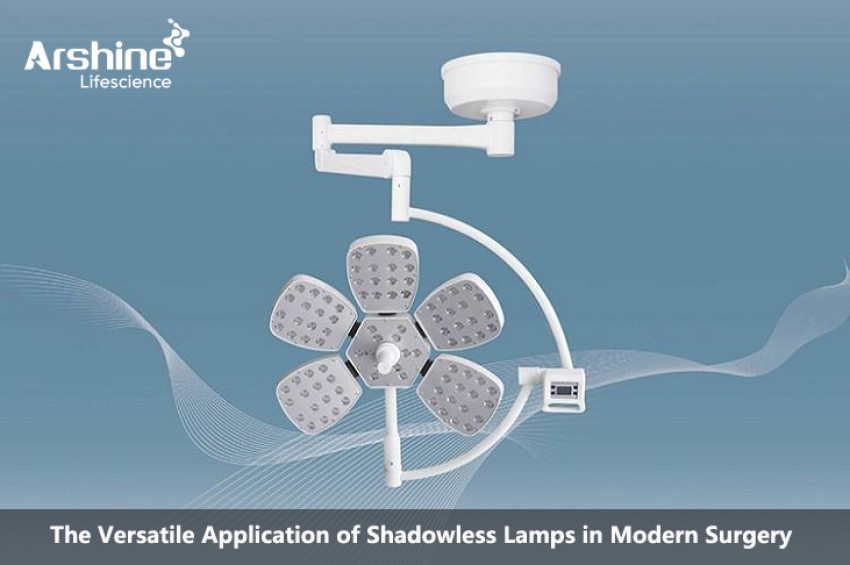
Introduction:
Shadowless lamps, also known as operating room lights or surgical lights, are an essential piece of equipment in modern surgical settings. These lamps play a crucial role in providing optimal illumination to the surgical field, allowing surgeons and medical teams to perform intricate procedures with precision and accuracy. In this comprehensive article, we will explore the diverse applications of shadowless lamps and their importance in enhancing patient outcomes, surgical efficiency, and safety.
Understanding Shadowless Lamps:
Shadowless lamps are specialized medical lighting devices designed to eliminate or minimize shadows in the surgical field. These lamps use advanced technologies, including high-intensity bulbs, reflectors, and lenses, to provide a uniform and focused illumination without causing glare or discomfort to the surgical team.
The primary goal of a shadowless lamp is to ensure that the surgical site receives consistent and shadow-free lighting from various angles. This allows surgeons to visualize anatomical structures clearly, distinguish tissues, and perform intricate procedures with utmost precision.
1.General Surgery:
In general surgery, shadowless lamps are extensively used for a wide range of procedures, including appendectomy, cholecystectomy, hernia repair, and bowel surgeries. These lamps provide a clear and bright light source that enhances the surgeon's ability to visualize vital structures, blood vessels, and nerves during the operation.
Moreover, shadowless lamps with adjustable color temperatures and brightness levels allow surgeons to tailor the lighting conditions based on the specific needs of the procedure and individual surgeon preferences. This flexibility ensures optimal visualization, reducing the risk of errors and complications.
2.Cardiothoracic Surgery:
In cardiothoracic surgery, precision and clarity are paramount. Shadowless lamps are indispensable tools during procedures like coronary artery bypass grafting, valve replacement, and congenital heart defect repairs.
The ability of shadowless lamps to provide a focused and well-distributed light enables cardiothoracic surgeons to navigate complex anatomical structures, suture delicate tissues, and perform intricate repairs with heightened accuracy. Additionally, adjustable light intensity and color temperature help in differentiating tissues and assessing tissue viability during the procedure.
3.Neurosurgery:
Neurosurgery involves delicate procedures on the brain, spinal cord, and nerves. The success of these procedures depends heavily on the surgeon's ability to see minute details and avoid damaging critical structures.
Shadowless lamps equipped with advanced optics and adjustable spot size are essential in neurosurgery. The precise control over the light beam allows neurosurgeons to focus on specific regions of interest and minimize light spillage, ensuring an unobstructed view of the surgical field. Furthermore, color-corrected light enhances tissue visualization, contributing to better patient outcomes and reduced complications.
4.Orthopedic Surgery:
Orthopedic procedures, such as joint replacements, fracture repairs, and spinal surgeries, require meticulous precision and visualization of bone structures and surrounding tissues.
Shadowless lamps with excellent depth perception and sharp focus are instrumental in orthopedic surgery. Surgeons can accurately assess the alignment and positioning of implants, ensure proper joint movement, and identify any misalignments or complications during the procedure. The consistent and shadow-free illumination also aids in maintaining a sterile environment and reducing the risk of infection.
5.Obstetrics and Gynecology:
In obstetrics and gynecology, shadowless lamps are used for various procedures, including cesarean sections, hysterectomies, and laparoscopic surgeries.
Shadowless lamps with adjustable intensity and positioning facilitate improved visualization of the surgical site, enhancing the surgeon's dexterity and minimizing the risk of inadvertent injuries. The ability to focus the light precisely on the target area ensures safe and successful surgeries, especially in critical situations such as emergency deliveries.
6.Ophthalmic Surgery:
Ophthalmic surgery demands exceptional visual clarity and accuracy. Procedures like cataract extraction, corneal transplant, and retinal detachment repair require specialized lighting systems to achieve optimal results.
Shadowless lamps designed explicitly for ophthalmic surgery deliver high-intensity light with minimal heat emission, safeguarding delicate eye tissues. These lamps also feature precise positioning and a broad range of motion, allowing ophthalmic surgeons to target specific areas within the eye with minimal disruption.
7.Plastic and Reconstructive Surgery:
Plastic and reconstructive surgery involve intricate procedures to restore form and function to various parts of the body, such as the face, hands, and breasts.
Shadowless lamps with excellent color rendition are particularly valuable in plastic surgery, as they aid in accurately assessing skin tone, texture, and vascularity. The ability to adjust the light's color temperature helps surgeons match skin tones and evaluate tissue perfusion during reconstructive procedures, ensuring natural-looking results and reduced scarring.
8.ENT (Ear, Nose, and Throat) Surgery:
ENT surgery encompasses procedures on the ears, nose, throat, and related structures. These surgeries demand clear visualization and precise illumination to address delicate anatomical features.
Shadowless lamps designed for ENT surgery offer adjustable light patterns and high-color rendering, enabling surgeons to focus on intricate structures while minimizing reflections and glare. The combination of shadow reduction and high clarity aids in removing obstructions and performing precise tissue dissection during sinus surgeries, tonsillectomies, and middle ear procedures.
Conclusion:
Shadowless lamps have become indispensable tools in modern surgery, revolutionizing the way procedures are performed across various medical disciplines. Their ability to provide consistent and shadow-free illumination enhances surgical precision, reduces the risk of errors, and improves patient outcomes.
As technology advances, the development of intelligent lighting systems with additional features like integrated camera systems, touchless controls, and sterile covers continues to enhance the versatility and usability of shadowless lamps in the operating room.
Surgeons and healthcare facilities must invest in high-quality shadowless lamps to optimize surgical outcomes, improve patient safety, and uphold the highest standards of surgical excellence. The seamless integration of these advanced lighting systems into surgical practice exemplifies the progress of medical technology in transforming healthcare delivery and patient care.
https://www.arshinemedical.com/Industry-information/the-versatile-application-of-shadowless-lamps-in-modern-surgery



